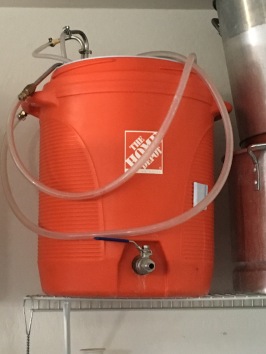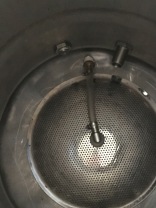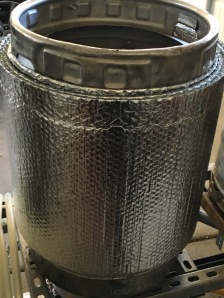Brew Day Part 2 – Mashing
Mashing
Mashing is probably the most boring but most important part of the brew day. Mashing is nothing like it sounds. It’s the process of extracting the sugar from the grains by soaking them at very specific temperatures. Those sugars will then be converted to alcohol by the yeast.
How Does It Work?
Water is heated to a predetermined temperature usually calculated by the brewing software, generally 10 degrees higher that the mash temperature. Mash temperatures are typically between 145 and 158 degrees depending on the type of beer you’re making.
Once you have your water heated to the proper temperature, the water is transferred into the mash tun and mixed with the grain. Some add the water to the grain and others add the grain gradually to the water. I have always had good results with adding the water first and then adding the grain, but I don’t think there’s one right way to do it. Experiment and see what you like.
After you’ve ‘mashed’ the grain, you just wait. That’s why this step is boring because there isn’t much for you to do, it’s a time to just let the magic of brewing happen. It’s also a good time to get all your ingredients ready for the boil and get your sparge water ready.
Why Does It Work?
I just called it ‘magic’ but really it’s chemistry at work. The sugars are extracted from the grain by two enzymes that are present during the mash temperature called alpha and beta amylase. The enzymes break down the starches from the grain into glucose, maltose, maltriose and dextrins. The first 3 sugars are fermentable by yeast and will become alcohol while dextrins are not fermentable but do contribute to the body and fullness of the beer.
Temperature is very important to the mash process. If you do not stay within the proper temperature range, the enzymes won’t be able to work properly. The enzymes work well together between temps of 145-158 degrees. The higher side of that range will give you more of a heavy body beer because more dextrins will be formed. If you go on the lower range of the temperature or use longer mash times, you will produce a lighter body with more alcohol. This is how your mash temp can greatly change your beer.
What Is A Mash Tun?
A mash tun is simply anything you use for doing the mash. You need something big enough to hold the grain and mash water. More importantly, you need something that is good at holding temperatures. You need to try and hold mash temps consistent for 60 minutes and most cases. Luckily, there is an extremely simple solution:

Yes, this blast from your past is the perfect mash tun with a little bit of a modification. This the 5 gallon mash tun that I used previously with my 5 gallon batches and it worked great. Once you put that lid on, the temperature is practically locked in. I’ve rarely had more a degree or two loss over the 60 minute mash.
These water coolers can be bought in many different places. As you can see I got mine from Home Depot. You will also nee
d to make a few adjustments to make it a mash tun. You can buy conversion kits online or likely at your local homebrew shop.
The most important part of the conversion kit is the false bottom. The false bottom goes on the bottom of the mash tun and attaches to the valve. When you drain the mash tun, it filters the wort so that very few of the grain particles pass through the valve into the
boil kettle. I’ve always used a false bottom but others prefer to use a bazooka screen which will do the same job.

I am now using a converted 15.5 gallon keg as a mash tun. I’ve had mixed results so far. I was surprised by how much the temperature dropped when I just used the keg. I was scared that the batch wouldn’t turn out, however, it was just fine. In fact, I was closer to my target gravities than I have been in several batches.
To help with the temperature issue, I wrapped the keg in Reflectix, which is pictured to the left. The temps kept better but still not very good. Once I complete the system, I will be using temperature controlled burners to keep the mash temps.
Next I will tell you about sparging which is the process when the
Posted on February 23, 2016, in Uncategorized. Bookmark the permalink. Leave a comment.
Leave a comment
Comments 0